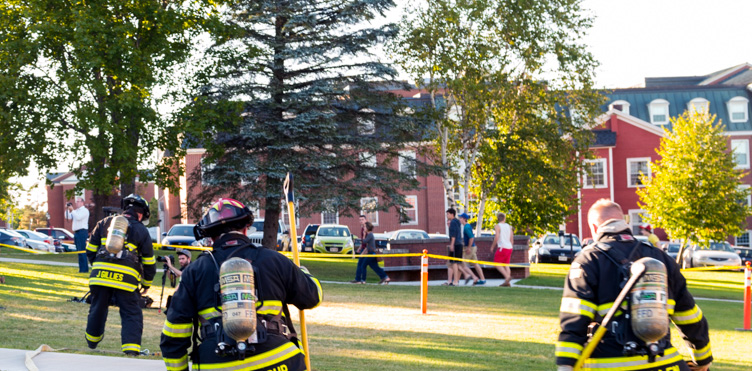What to do in case of fire or explosion

Upon discovery of fire
- Evacuate fire area immediately. Do not lock the doors behind you.
- Activate fire alarm (pull box).
- Leave the building using nearest safe exit or stairwell. Do not use elevators. Assist persons with disabilities. Remain calm and assemble outside building entrance at least 9m away from the building.
- Call fire department (dial 9-1-1) and provide your name, phone number and location (UNB campus, building and room number).
- Notify Security: dial (506) 453-4830; use blue emergency phones, red emergency phones inside buildings or press direct access key on coin operated phones on campus.
- Notify Security immediately if you extinguish a fire or to report smoke or fumes.
Upon hearing a fire alarm
- Leave building via nearest exit.
- Call Fire Department (from outside the building).
Fire extinguishers
Use a portable fire extinguisher to extinguish small fires only. Do not use a fire extinguisher unless you have received training in its proper use. Report any fire extinguisher that has been discharged to Facilities Management at 453-4889 or by email at fm@unb.ca.
- Ordinary combustible fire (wood, paper, cloth) - Use extinguisher type A or A-B
- Flammable liquid fire (gasoline, paint, oil, grease) - Use extinguisher type A-B, B-C or A-B-C
- Electrical equipment fire (electrical wiring or panel) - Use extinguisher type B-C or A-B-C
- Combustible metals test (metals) - Extinguish using a bucket of sand
Fire procedures
Fire
UNB Reference Number: 7802
Authorized by: Thomas J. Condon, Acting President
Effective date: Dec. 12, 1979
Revised: September 2001
Intent: To outline procedures for handling fire emergencies.
Scope: All persons.
Procedures
In case of fire:
- activate the nearest wall-mounted fire alarm
- telephone the Fire Department 911
- telephone the Security Office
- evacuate the building
- do not use elevators
- report to attending fire fighter or building warden
In case of fire alarm:
- evacuate the building (even if the alarm is suspected of being false)
- do not use elevators
After evacuating a building do not re-enter until authorized by fire fighters, U.N.B. security officers, or building wardens. Cessation of alarm bell does not indicate that the building is safe to re-enter.
All smoke or fumes of undetermined origin must be reported to the Security Office.
Building evacuation procedures should be reviewed annually by individual building safety committees.
Report as soon as possible to the Physical Plant department any fire extinguisher that has been discharged.
Fire exits
UNB Reference Number: 7829
Authorized by: J. M. Anderson, President
Effective date: Dec. 1, 1978
Revised: September 2001
Intent: To outline standards for maintenance of exits.
Scope: All persons using facilities belonging to the University.
Hazard: In order to allow egress from an area or building in case of fire or other emergency, it is important that all exits (including doors, stairways, and corridors) be maintained free of obstruction or hazard.
Policy
Placement of equipment in corridors is feasible only if:- corridor space is unusually ample.
- no fire or accident hazard is created.
- movement of people is not obstructed.
- required exit width is not reduced.
Requests for utilization of corridor space must be approved by the Physical Plant Department; approval of such requests will depend upon compliance with applicable legislation.
Storage in any enclosed exit stairway is prohibited.
The movement of doors and access to doors that allow exit from any area shall not be obstructed.
The storage of bicycles in stairways or corridors of University buildings is prohibited by the National Fire Code and UNB Security Department policy. Fire Fire Exits Building Occupancies Fire Safety Equipment in Buildings
Building occupancies
UNB Reference Number: 7830
Authorized by: J. M. Anderson, President
Effective date: Dec. 1, 1978
Revised: October 2001
Intent: To specify the controls and limitations in regard to building occupancies.
Scope: All persons using University building facilities.
Policy: The use of any area within the building must comply with all applicable statutory regulations, including:
- The National Building Code
- The National Fire Code
- The Liquor Control Act
- Municipal By-laws
Reservation of space within a University building is made through the Registrar's Office or the Residence Administration Office (for conferences). All pertinent information regarding occupancy limits will be supplied by these offices.
Copies of all reservation confirmations will be forwarded to the Security Office and the Physical Plant Department.
Persons wishing to use a building facility for a public gathering, as defined by the Liquor Control Act, must provide adequate supervision to ensure that all pertinent fire and safety regulations are adhered to. Information as to the number of supervisors required for an event will be supplied by Security or the room reservation offices.
The Department of Physical Plant maintains information on the maximum occupancy in areas used for public gatherings.
Fire safety equipment in buildings
UNB Reference Number: 7831
Authorized by: J. M. Anderson, President
Effective Date: December 1, 1978
Revised: September 2001
Intent: To outline requirements related to fire safety equipment for users of University facilities.
Scope: All persons using facilities belonging to the University.
Hazards: If fire safety equipment is obstructed or tampered with the probability of controlling an outbreak of fire is greatly reduced.
Requirements
- Access to fire alarm pull stations must not be obstructed.
- Access to hose cabinets, extinguishers and other fire safety equipment must not be obstructed.
- No person may use fire fighting equipment, other than in case of fire, nor shall any such equipment be located or relocated without the written permission of the Physical Plant Department.
- Self-closing mechanisms on fire doors must not be disabled, nor may fire doors be locked open. If a fire door is found not to be self-closing, it should be reported to the Physical Plant Department.
